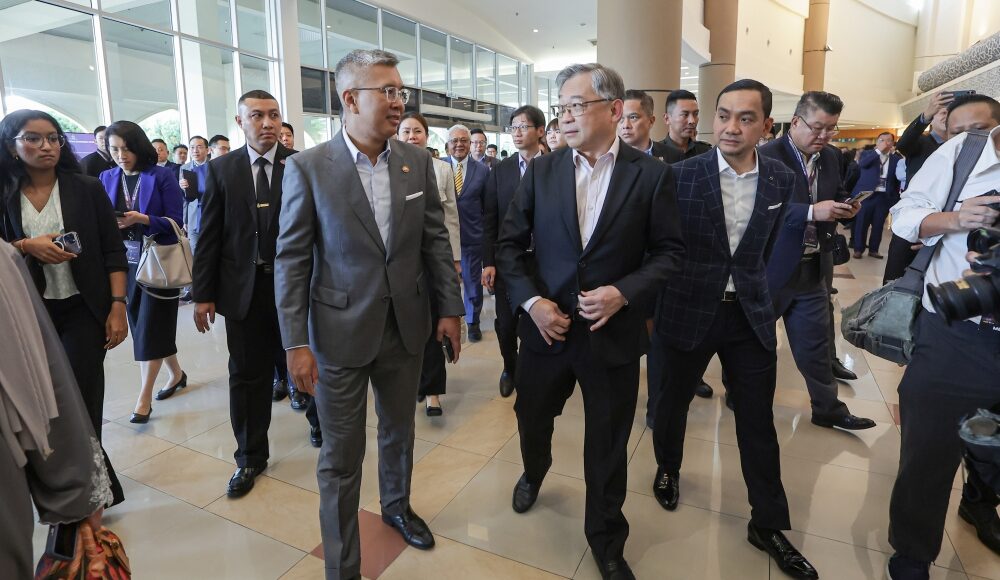APRIL 26 — I just returned from a trip to Washington DC. I believe the Miti team had productive engagement sessions on April 24 with the US Secretary of Commerce, Howard Lutnick and the US Trade Representative, Ambassador Jamieson Greer.
Malaysia stands ready to continue collaborating with the United States (US) regarding President Trump’s reciprocal tariffs, and we remain open to negotiations in four key areas: reducing the trade deficit; addressing non-tariff barriers; strengthening technological safeguards and security; and exploring a potential bilateral trade agreement.
Several days ago, on April 21 to 22, Miti collaborated with the state of Johor and Singapore’s Ministry of Trade and Industry (MTI) – as well as other partners in government and the private sector – to successfully organise the inaugural Johor-Singapore Special Economic Zone (JS-SEZ) Joint Business and Investment Forum in Johor Baru.
How do these two events connect? For a start, I mentioned during my keynote at the forum on how the heart of the Malaysia-Singapore relationship lies in the fact that both countries are at our best when we work together, and there is no better time to strengthen that partnership than through the JS-SEZ, while many countries are searching for the best solutions to ensure a softer economic landing due to US tariffs.
In 2024, Malaysia and Singapore were each other’s second-largest trading partner, while Singapore was Malaysia’s largest export destination. Our trade in 2024 was a robust US$86.69 billion, driven by E&E products, petroleum products, machinery and others.
Indeed, when Malaysia and Singapore entered the MOU on JS-SEZ in January 2024, no one expected that, 15 months later, President Trump would drop the US reciprocal tariff ‘bomb’ on all its trading partners.
I believe this sentiment was also shared by the 1,000 or so attendees of the two-day JS-SEZ business forum. So, moving forward, how do we leverage on the 3,588-square km JS-SEZ to build resilience in the current global trading scenario?
Investment, Trade and Industry Minister Datuk Seri Tengku Zafrul Abdul Aziz and Deputy Prime Minister of Singapore Gan Kim Yong taking a brief tour at an exhibition held in conjunction with the Johor-Singapore Special Economic Zone (JS-SEZ) Joint Business and Investment Forum at the Persada Johor International Convention Centre April 21, 2025. — Bernama pic
JS-SEZ’s fundamentals unrivalled
Regardless of what is happening in the world, to Malaysia, the JS-SEZ offers an unbeatable strategic location, connectivity, rule of law, abundant resources and skilled talent to attract high-quality investments in sectors such as advanced manufacturing, logistics, green technology, and digital services into Johor. For Singapore, it provides space and scale to support its businesses as they expand, leveraging Johor’s land and power availability, as well as Malaysia’s talent pool.
This offers a cross-border ecosystem for MNCs looking for stability, scalability, and sustainability. I dare say that the JS-SEZ is in a sweet spot, particularly in a situation where Trump’s tariffs are fast changing trade from a bridge to becoming a barrier, and global investors reconfigure their supply chains to make them more resilient. Thus, we must seize the opportunity to quickly carve out a powerful presence for the JS-SEZ in regional or global supply chains.
Inclusive growth and benefits
Even while we keep engaging with the US, the Madani Government has also been diversifying our markets and reforming our economy. The JS-SEZ plays a crucial role in supporting both objectives.
In economic reforms, for example, Miti regards the JS-SEZ as a massive ‘industrial park’ that will be a perfect launching pad for many of our initiatives under the New Industrial Master Plan 2030 (NIMP2030). We are also determined to ensure that the bulk of the 20,000 skilled job opportunities are taken up by Malaysians, particularly through initiatives like the Johor Talent Development Council (JTDC).
What about SMEs?
During our forum, there was much discussion on integrating Malaysian SMEs into the regional and global supply chains by supporting both MNCs and local companies based in Johor. The JS-SEZ will also help SMEs tap opportunities arising from the Singapore side, acting as a base for them to access greater logistics and exports enablers to the Asean and Asian markets.
Bear in mind, too, of the potential benefits of a successful JS-SEZ for both ordinary Malaysians and Singaporeans. Traffic congestion and quality of life will improve dramatically once we can create passport-free QR code clearance for everyone at the Malaysia-Singapore border.
All hands-on deck for JS-SEZ
That brings me to the second question: will Malaysia, Singapore and Johor remain committed to the massive undertaking vis-à-vis the JS-SEZ? The most compelling argument is the unity of purpose and effort between the governments involved – I felt honoured and privileged to share the stage with Datuk Onn Hafiz Ghazi, the Menteri Besar of Johor and Gan Kim Yong, Singapore’s Deputy Prime Minister and Minister of Trade and Industry during the forum.
But even before the forum, Miti had been busy leading the Working Group for ‘Ease of Doing Business’, while actively supporting others like the Economic Sector (led by the Economic Ministry), Movement of Goods (led by the Royal Malaysian Customs Department) and Talent (led by Ministry of Human Resources). Agencies like Mida, Irda and Invest Johor have been actively collaborating with various local councils in Johor, too.
These have led to some quick wins, including the establishment of the Invest Malaysia Facilitation Centre Johor (IMFC-J) on February 18, a significant milestone in streamlining investment processes for the JS-SEZ.
JS-SEZ must grow
Therefore, the commitment of all three parties to the JS-SEZ is undoubtedly clear. In expanding the JS-SEZ scope, for example, the Federal government supports the Johor state’s proposed regulatory sandbox initiative, which will be instrumental in unlocking new waves of sustainable, high value investments that will benefit both local stakeholders and international partners.
Given the JS-SEZ’s strategic location at the heart of South-east Asia and Asia, we also aim for the JS-SEZ to support these regional supply chains, which must be championed well beyond Malaysia’s 2025 Asean Chairmanship.
This was already exemplified by the MoU exchange at the forum – between Tanjung Langsat Port and Pertamina Energy Terminal – aimed at achieving an annual trading volume of three million tonnes within JS-SEZ.
This is also why Miti welcomes the Johor Menteri Besar’s proposal to establish an Asean (or even RCEP) Industrial Park within the JS-SEZ, to foster economic integration and attract high-value investments from within Asean and beyond. The focus should be on enhancing supply chain efficiency and resilience in Malaysia-Singapore industries that complement, rather than compete, such as R&D, biotechnology, and renewable energy.
There will be skepticism, no doubt, but we must stay the course. Considering how global trade is evolving (potentially for the worse), Malaysia and Singapore must harness their complementary strengths to elevate ourselves regionally vis-à-vis the JS-SEZ.
With the right public-private support from both sides of the Causeway, the JS-SEZ can emerge as a regional economic powerhouse to strengthen both Asean and Asia’s supply chain, while serving Asia’s 4.7-billion strong market. What is clear is that in this quest, both Malaysia and Singapore can be winners via the JS-SEZ.
* Datuk Seri Tengku Zafrul Abdul Aziz is Malaysia’s Investment, Trade and Industry Minister.
** This is the personal opinion of the writer or publication and does not necessarily represent the views of Malay Mail.





